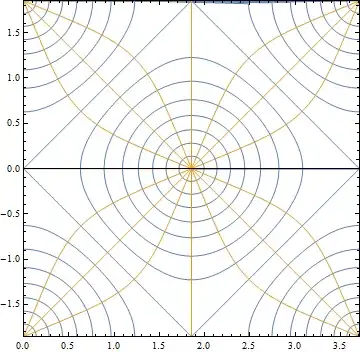Charles Sanders Peirce wrote$^\dagger$ about
an orthomorphic or conform projection formed by transforming the stereographic projection, with a pole at infinity, by means of an elliptic function.
("Conform projection" seems to mean what today we would call a conformal projection.)
For that purpose, $l$ being the latitude and $\theta$ the longitude, we put $$ \cos^2\varphi = \frac{\sqrt{1 - \cos^2 l \cos^2\theta} - \sin l}{1 + \sqrt{1-\cos^2 l\cos^2\theta}},$$ and then $\dfrac 1 2 F\varphi$ is the value of one of the rectangular coördinates of the point on the new projection.
Here two questions arise: $(1)$ What is $F$? $(2)$ What does this have to do with elliptic functions?
This is the same as taking $$ \cos am (x+y\sqrt{-1}) = \text{(angle of mod. $=45^\circ$)} = \tan \frac p 2 (\cos\theta + \sin\theta\sqrt{-1}), $$ where $x$ and $y$ are the coördinates of the new projection, $p$ is the north polar distance.
I take this to mean $p$ is the great-circle distance from the north pole to the point being mapped (where the great-circle distance from the north pole to the south pole is $\pi$), and $\tan(p/2)$ is the distance from the image of the north pole in the stereographic projection to the image of the point being mapped. But what does $\text{“angle of mod.''}$ mean? And what is $am$? And where are the elliptic functions here?
(For now, I'm omitting the one occurrence in the history of human language of the phrase "orthomorphic potential". )
Despite not knowing the answers to the questions above, I know where Peirce is going: He has a multiple-valued mapping from the sphere to the plane that maps the whole sphere in a periodic way to each of infinitely many non-overlapping copies of a $2\times1$ rectangle, and this mapping is conformal except at isolated points.
$\dagger$ C. S. Peirce, "A Quincuncial Projection of the Sphere", American Journal of Mathematics, volume 2, number 4, December 1879, pages 394–6

